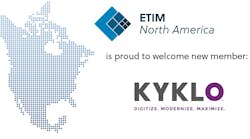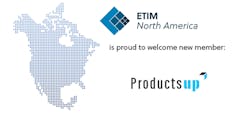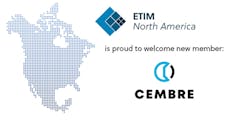IBM Corp. has recast its thinking on suppler relations, much to the elation of Graybar and Schneider Electric.
Winning a sole-supplier contract on a major national account is an extremely difficult thing to do, and perhaps justifies the trumpet fanfares and public-relations barrages companies unleash when they win one. After all, the challenge of the national-account game is that it often requires first convincing all the myriad influences in a major corporation that they can get a better deal by completely reorganizing the power structure of their purchasing operations and concentrating their sales with one supplier rather than putting every little purchase out to bid. There are only so many customers that have both the size and willingness to do this. Once you find them and convince them that the idea is sound, you must convince them that your company (or network of companies) is the one they ought to trust with all this business. When you lose one, it will very likely be three to five years before you have another chance at that account again. The stakes are high, the odds are long and the negotiations can be gruelling and endless.
Once the contract is won, though, the work can get even harder. A customer who assigns many millions of dollars in purchases to a single supplier expects a lot of attention from that supplier, and more than one distributor has been hurt over the years by an imbalance between their output for their largest accounts and the margins they earn on those sales. But done properly a national account agreement can push organizations to go beyond the status quo and develop new capabilities that benefit other customers as well.
Case in point: When a company the size of International Business Machines Corp. (IBM), Armonk, N.Y., decides to put all its purchasing eggs in your basket, you're going to keep a close eye on that basket. IBM, the quintessential blue-chip national account, last year decided to buy all electrical distribution and control equipment used at its North American facilities from a single manufacturer. The preferred supplier agreement ultimately went to Schneider Electric (formerly Groupe Schneider) supplying IBM's facilities via Graybar Electric's nationwide network of branch locations. In putting the agreement to work, Graybar, based in St. Louis, Mo., and Schneider, whose North American Division is based in Palatine, Ill., believe they have found a balance in which all three companies can prosper.
The computer giant's objective in taking the single-supplier approach is to gain a competitive advantage by reducing the time and resource costs associated with procuring, designing, constructing and maintaining electrical systems at the company's 21 U.S. sites. Less than two years into the contract, IBM says it is seeing substantial benefits-enough that it has already expanded the agreement to Schneider Electric's home market in France, and is considering expanding it to other products and geographic areas as well.
The interests at stake for Schneider and Graybar are substantial. IBM estimates its total U.S. electrical equipment purchases at around $25 million annually, of which about $11 million falls into the categories of product made by Schneider Electric and marketed in the U.S. primarily under the Square D and Modicon brands. IBM's U.S. facilities include some extremely active consumers of electrical equipment.
In Essex Junction, Vt., for example, near the city of Burlington, the IBM Burlington plant sits on 715-acres along the banks of the picturesque Winooski River. The site's total facilities enclose 3.3 million sq ft of space, including some of the largest semiconductor fabrication facilities on the planet. IBM Burlington employs 7,000 people in development and production of memory, logic and microprocessor chips, making it the largest private employer in Vermont. (Just as a refresher, memory chips store data, logic chips process data and microprocessors combine a computer's processing functions on a single logic chip.)
The manufacturing process uses photolithography and a chemical-based etching process to create sub-microscopic electrical circuits in patterned layers in and on silicon wafers. Each wafer takes months to produce. It all happens in ultra-clean rooms controlled to submicroscopic tolerances, where small electric shuttlecraft scurry along electrified rails, carrying wafers of silicon from station to station over the heads of workers in space suits.
All this high-technology processing uses lots of electricity. IBM Burlington has more than 120 electrical substations in sizes up to 15KV, handling a total of 130KV of power. The stability of the power is critical. The plant operates on a 24 x 7 continuous-process schedule that halts only two days a year-for Thanksgiving and Christmas holidays. A shutdown at Burlington can cost IBM greater than $1 million a day, and the problems it would cause run beyond interrupted processes, lost production time and wasted product, says Prab Kamath, site director of IBM Burlington. Loss of power also means many of the machines and instruments must be recalibrated, which is expensive and time-consuming. Reliability of the systems and responsiveness of the distributor are major issues for these plants.
IBM Burlington, like IBM's other sites, has its own purchasing staff making autonomous decisions on supplier selection. Centralized purchasing decisions at first caused some concerns among buyers, but now, according to Kamath, the site is seeing substantial savings in engineering and procurement costs and increased confidence about security of supply by working with a single source.
Burlington and three manufacturing plants in New York state-Endicott, Poughkeepsie and East Fishkill-form IBM's Northeast region, where the agreement with Schneider and Graybar was conceived and developed. The current relationship between IBM and Schneider Electric had its seeds in an early-1996 move to standardize controllers throughout the plants in the Northeast region. The engineers at those sites saw standardization as a way to cut down on all the retraining, redundant inventory and technical problems that came with using a variety of controllers, each with its own proprietary programming and interface needs. They chose Modicon primarily because it used an open system architecture called Modbus, which made it easy to interface with other systems, particularly the Intellution monitoring and alarm systems IBM's plants used.
IBM did a study, comparing the automation strategy of its Northeast plants before and after the move to standardized controllers, that showed the combined savings from standardization and volume pricing had cut the plants' costs for instrumentation, controller hardware and software, and field installation and testing by a total of 40%, according to Bill Schaphorst, strategic accounts manager for Schneider Electric. Schaphorst is Schneider's point man in the IBM contract, the manager whose job it is to make sure Schneider is living up to its commitment to IBM.
Shortly after that study, another IBM task force was looking at the electrical power distribution systems of the Northeast region and saw the savings from the automation alliance. That team, led by Brian Murphy, manager of site utility systems at the Endicott plant, enlisted Schneider's representatives in a brainstorming session to explore the benefits of a strategic account agreement covering a large basket of distribution and control products. The team then approached the three largest manufacturers of electrical distribution and control systems in the U.S., and all three made proposals.
Drawing from a set of objectives laid out by Lou Gerstner, IBM's chairman, the task force was looking for ways IBM could change its design, specification and procurement of electrical distribution equipment to support faster construction of new facilities and faster implementation of new production technologies as well as efficiencies in procurement. Specifically, the team's goals were: to standardize the electrical distribution systems at all IBM sites in the region; to identify and share best practices in electrical distribution; to cut the costs of purchasing electrical distribution equipment and improve productivity and efficiency; and to streamline the purchasing process and shorten cycle times for project deliveries.
The team had a long list of expectations on which it evaluated the proposals (see box on page 31). IBM chose the Schneider package because Schneider seemed the most committed to the goals of the team, says Murphy. They had top-quality equipment that was efficient to install and use and employed leading technology; they had a nationwide alliance with a top-ranked distributor; they offered the best pricing structure and the best volume discounting; plus they had the controls alliance with a record of proven success, Murphy says.
Graybar's primary contribution to the winning proposal, beyond even its ubiquitous locations, came from its progressive deployment of information technologies such as EDI and bar-coding. "The real-time information system Graybar offers, with the ability to report sales by locations, was a key component," Murphy says.
The role of information in securing the agreement is the way of the future, says Chuck Holstrom, Graybar's national accounts manager, and the Graybar point-person on the IBM account. "How you handle information is becoming more and more important for the industry," says Holstrom. "You have to use it to take cost out of the (customer's) whole corporation."
The choice of Graybar nationwide was not universally popular with other Square D distributors who had a history of business to protect in IBM plants, but Schaphorst stands by the decision. With the need to cover a broad smattering of locations and moreso the need to track, consolidate and report sales through a centralized system, having one distributor handle it was the most efficient solution for the customer, he says.
The other distributors still sell to IBM, which buys all electrical equipment not covered by Square D via the traditional bidding processes. But the task force is considering reducing suppliers in those product categories as well. There were some areas of concern to be resolved before implementing the agreement. For instance, most of IBM's plant engineers had no experience with Schneider's engineering and service capabilities. IBM also wanted assurance that Graybar could take care of every IBM facility with rapid, consistent service and assurance that it could outsource certain major equipment from other manufacturers. IBM, Schneider and Graybar resolved these concerns, and in June 1997 the full distribution and control alliance was rolled out in the Northeast.
The agreement began as a three-year term for the Northeast region, where the companies developed operating procedures and system standards. It was later expanded to include all IBM sites in North America and was rolled out in the U.S. over the past year.
The development of new standards for the electrical distribution systems was a major undertaking involving close and intensive teamwork between IBM and Schneider engineers. The engineers developed systems that can be deployed, using the same components in a consistent set of configurations, in any IBM site.
This standardization has driven a vast number of improvements and efficiencies in IBM's processes, Murphy says. Once the standards were finalized, they were posted on IBM's site on the Internet, where IBM engineers, consultants and members of the IBM "value chain" can download the specs, making development of new construction projects much more efficient. The standardization also cut redundancies in training operators to use different brands of equipment, cut spare-parts inventories and cut down the number of project delays.
"Now a purchase doesn't even happen until after the engineers and the manufacturer have worked out the details of the system," Murphy says. "That means fewer change orders, and the product goes in easy."
Enormous savings come as well on the purchasing side from standardizing centrally on one line of product, says Gary DiNardo, buyer in IBM's World Wide Procurement operations. Just by not having to shop around, not having to go through all the technical analysis to determine whether an "or equal" is actually equal, the savings are considerable, DiNardo says.
The purchasing department still exercises business controls, including semi-annual audits, and purchasing people still periodically put distribution and control purchases out to bid, just to make sure IBM is getting the best deal it can. Engineers have the freedom to buy outside the agreement if another company's product is the better solution, but such cases are the exception.
Standardization has especially paid off in delivery cycle times for construction projects. IBM has made it a competitive goal to build and implement new production on an ever-faster schedule. "They believe there's no reason to have money sitting in a bank once approval for a project has been given," says Schaphorst of Schneider.
Because the sources of supply no longer depend on the electrical contractor's connections and preferences, once the design of a new facility is finalized, IBM can "advance-procure" the needed equipment, Graybar can do a pre-takeoff and Schneider can schedule production time for the order in its factories. Sometimes the product will arrive at the local Graybar branch even before the electrical subcontractor has been identified.
Most of the electrical products that go into IBM's plants arrive via the indirect route. IBM has a vast network of third-party "value-chain members" who supply them with completed machines and subsystems. Schneider and Graybar engineers work closely with IBM's value-chain members to help them integrate Schneider products into their systems, which makes it easier for IBM's maintenance people to keep those systems operating efficiently once they're installed.
One of Graybar's jobs is to keep track of all Schneider product sales to IBM plants, including all sales that go through value-chain members. Graybar issues regular operating reports to IBM showing in intimate detail what products were bought, when they were delivered, their cost, the savings from what they were paying for similar products before the agreement, the level of discount applied and so forth, whether the products are delivered to an IBM plant or an IBM value-chain member. It's a level of knowledge IBM never had before, but that required little extra work from Graybar. Through its central system, Graybar communciates with all its facilities in real time. The most difficult part of synchronizing all the data flow for IBM has been getting the data entered consistently at every site, says Holstrom. The rest is handled by the system.
Graybar supplies IBM's plants using its standard distribution network of branches fed by its new regional distribution centers. The local Graybar sales reps and account managers are the IBM plants' first point of contact in the Schneider supply chain, "the ones who live this relationship on the local level," says Schaphorst of Schneider. At each Graybar location serving an IBM plant there are sales people assigned exclusively to IBM, according to Holstrom.
These people are supported by district vice presidents, district sales managers and district industrial marketing managers. At the corporate level, Graybar has assigned exclusively to the IBM agreement a national accounts services coordinator, who oversees the operational issues, and a national accounts services administrator, who oversees the accounting side of the agreement. Holstrom, being national accounts manager for all of Graybar, also devotes much of his time to the IBM agreement.
Schneider Electric's support for the IBM agreement begins with Schaphorst, who is almost evangelical in his zeal to take care of his customer. In addition to Schaphorst, there's a dedicated sales executive in Albany, N.Y., who works with all the contractors and systems integrators, and a dedicated applications engineer who provides technical application support. Schneider also has an individual assigned to each IBM facility to oversee the agreement on the local level, working closely with the Graybar branches.
At both companies, support for the IBM contract penetrates to the upper executive offices. A recent idea-exchange meeting brought together top-level executives from Schneider and IBM to discuss product marketing and other best-practice benchmarking information.
When the agreement was expanded last year to include all of the U.S., the three companies worked together on a major nationwide roll-out of the IBM-Schneider-Graybar agreement. A team representing all the groups involved-including Murphy, DiNardo, Schaphorst and Holstrom-traveled to every IBM plant in the U.S. and spent a day or two walking the purchasing and engineering staffs and local value-chain members through the agreement, answering their concerns and introducing them to local Schneider and Graybar personnel who would be their contacts.
The way the agreement was rolled out is something Holstrom says he will always remember and use in future rollouts of national agreements. "The same team rolled it out in all the locations, and we kept getting some of the same concerns, so each time we did it, we learned something that made the next one go a little smoother," Holstrom says. "It was a great way of communicating that this was a true partnership with support from the top levels of the company." Holstrom expects plenty of opportunities to put these observations to work. In fact, all three companies seem sold on the national preferred-supplier concept. Graybar has put together a new strategic accounts organization based on its experiences taking care of IBM. That new organization was still in the final formative stages as EW went to press, and Graybar was reluctant to talk about it. But the Graybar group clearly hopes to apply much of what it has learned at IBM to new customers' needs.
Schneider likewise is continuing to pursue major national accounts, but Schaphorst says there's a limit to the number of customers on which a company can lavish the kind of around-the-clock red-carpet treatment Schneider is giving IBM. In this case, the payoff is pretty clear. The agreement increased Schneider's sales to IBM by more than 100%, and the company is looking for opportunities to expand the alliance geographically.
IBM is considering similar agreements covering a broader basket of electrical goods. Graybar and other distributors have made proposals, but a multi-manufacturer supply agreement is proving much more complicated, and the IBM task force is considering its options carefully before making a decision. The Northeast region already is using the Schneider/Graybar agreement as a model for procuring other supplies such as de-ionized water handling equipment.
Murphy is trying to document savings from the agreement to benchmark against other procurement proposals. The tangible benefits already are pretty clear, with an approximately 10% cut in procurement costs, and a cut in construction project cycle times from several months before the agreement to 8-12 weeks under the agreement. The purchasing team has cut 15 to 20 suppliers. The intangibles are possibly even more substantial, says Murphy.
Meanwhile, for the people at Schneider and Graybar, life with IBM continues to evolve. "It's never like you have arrived," says Holstrom of Graybar. "It's (the alliance) growing and going well, and it's our intention to keep growing it. This is an exciting time we live in, and we're glad we have a part to play in it."
The team that put together IBM's preferred supplier agreement on electrical distribution equipment had a long list of expectations suppliers had to address: * fair discount pricing schedule based on volumes * same discount to any IBM subcontractor * expeditious production and shipping * extended warranties * current product updates and seminars * tracking regional volumes and costs * cost-plus agreement with distributor * major project application assistance * stable inventory of frequently used equipment * consistent high quality of service and products.
Supplier agreements are changing the world of industrial purchasing. An industrial buyer's work involves a lot of juggling, keeping the interests of the various camps of engineers, accountants and production teams in mind. The ultimate goal of getting the best deal possible to keep down costs and improve profits remains constant, but the route by which that goal can best be achieved may be changing, says Gary DiNardo, a buyer with IBM's World Wide Procurement operations, who works out of the company's semiconductor plant in Endicott, N.Y. Preferred-supplier agreements such as IBM's deal to buy all distribution and control equipment throughout its North American operations from Schneider Electric through Graybar Electric are shaking things up in purchasing departments and offering buyers new alternatives to the traditional, bid-heavy approach.
"Before this agreement, each project we did was competitively bid, which is time-consuming," says DiNardo. "Now we have multipliers for catalog items, so we know what they need, we know what everything will cost and we don't have to spend as much time with it."
This kind of tight-knit alliance between buyer and seller is a new phenomenon at IBM within the past two years, says DiNardo, and he sees more purchasing going in that direction, though he also says there will always be a need for niche suppliers and competitive bids.
Other trends in industrial purchasing, such as a trend toward reduced emphasis on face-to-face calls from distributor salespeople, have their upsides and their downsides for today's purchasing agent.
"I hate the guy who just shows up in the lobby and expects me to set aside time to see him," says DiNardo in response to a question about distributor salespeople. But cold calls are not commonplace, and "for the most part, the sales people are pretty knowledgeable and professional," he says.
In procuring supplies for large projects, DiNardo believes there has to be face-to-face contact between salesperson and purchasing agent. On other types of purchases, especially maintenance and repair supplies, he doesn't care whether he sees a salesperson on a regular basis.
Industrial purchasing has embraced the Internet as a source of information. IBM uses e-mail to obtain quotes from suppliers and the Web to gather background information such as Dun & Bradstreet reports, and to do product searches. DiNardo says access to suppliers' intranets is even more useful, allowing purchasing people to stay current with developments within a company.








